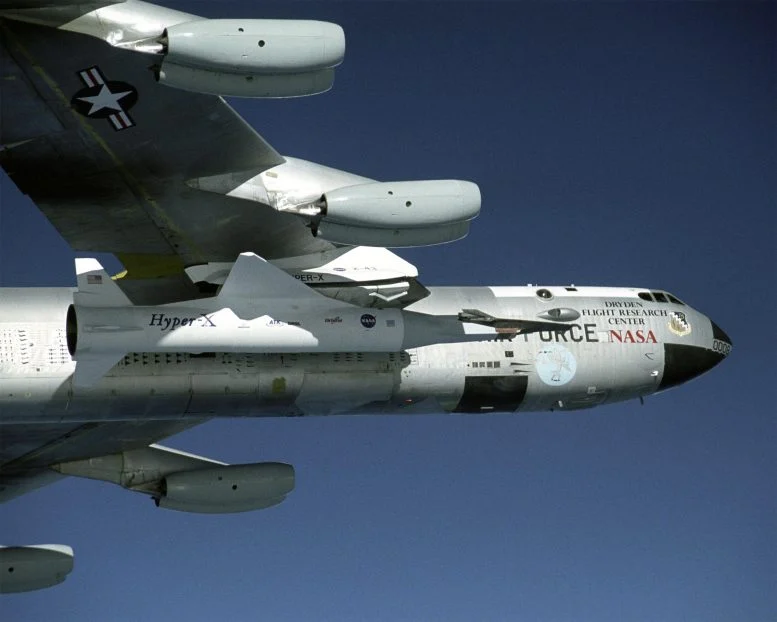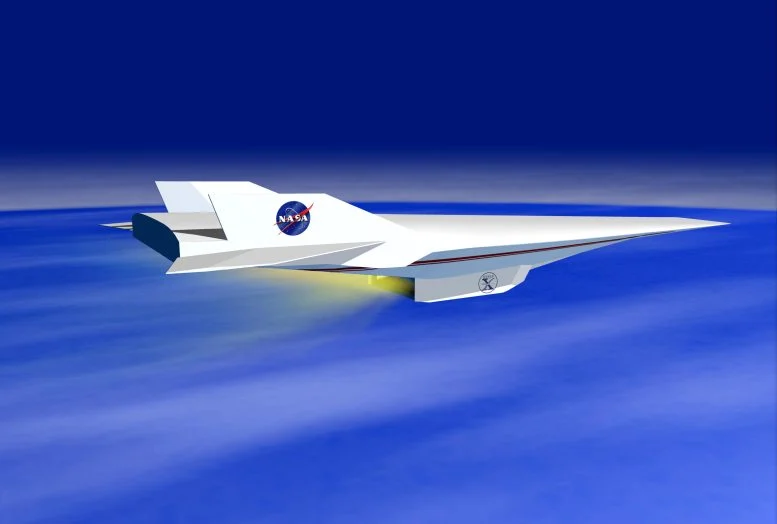Wind Tunnel Study Reveals Hypersonic Jet Engine Flow Can Be Controlled Optically
A team of researchers at the University of Virginia is working on harnessing hypersonic jets for trips into space using advanced developments in control and sensing. The work, according to NASA sponsorship, targets enhanced scramjet performance using adaptive control systems and optical sensing techniques that could eventually come up with a much safer and more efficient access to space vehicles that fly like aircraft.
Hypersonic Jets: Space TravelPCP-adm | October 3, 2021 | Space Travel
What if the future of space travel looks less like Space-X’s rocket-based Starship and more literally like NASA’s “Hyper-X,” the hypersonic jet plane which, 20 years ago this year, flew at faster-than-any-other-aircraft-before-or-since speeds?
In 2004, NASA’s final X-43A unmanned prototype tests were a landmark event in the newest era of jet development — the leap from ramjets to faster, more efficient scramjets. The last test, in November of that year, clocked a world-record speed only previously achieved by a rocket: Mach 10. That is entailed—a speed 10 times faster than sound.
NASA gathered a wealth of useful data from the tests, as did the Air Force six years later in similar tests on the X-51 Waverider, before the prototypes careened into the ocean.
While hypersonic proof of concept succeeded, the technology was far from operational. Of course, the challenge was getting control of the engine, since the tech was based on decades-old sensor approaches.

NASA B-52B Launch Aircraft Carrying X-43A Vehicle体
NASA’s B-52B launch aircraft cruises to a test range over the Pacific Ocean carrying the third and final X-43A vehicle, attached to a Pegasus rocket, on November 16, 2004. Credit: NASA / Carla Thomas
Breakthroughs in Hypersonic Engine Control
This month, however, brought some hope for potential successors to the x-plane series:.
Findings released in the June issue of the journal Aerospace Science and Technology by University of Virginia School of Engineering and Applied Science researchers, as part of a new NASA-funded study, demonstrate the first-ever capability to use an optical sensor in guiding airflow in supersonic combusting jet engines. This could be a major breakthrough toward an efficient way to stabilize hypersonic jet aircraft.
What is more, adaptive control over a scramjet was obtained by the researchers, which is also unprecedented in hypersonic propulsion.adaptive control systems for Engines respond to changes in dynamics, maintaining the optimum overall performance of a system.
“One of our national aerospace priorities for decades, since the 1960s, has been to build single-stage-to-orbit aircraft that fly into space from horizontal takeoff like a traditional aircraft and land on the ground like a traditional aircraft,” said professor Christopher Goyne, director of the UVA Aerospace Research Laboratory, where the research took place.
“The most advanced spacecraft in existence at this moment is the SpaceX Starship. It has two stages and does this vertical launch and landing thing that’s interesting to watch. But for maximum safety, convenience and reusability, the aerospace community really wants to do something more along the lines of a 737.”
Max Chern Wind Tunnel ▽
Graduate student Max Chern inspects the wind tunnel setup where University of Virginia School of Engineering and Applied Science researchers proved control of a dual-mode scramjet engine is possible using an optical sensor. Credit: Wende Whitman, UVA Engineering
Goyne and his co-investigator, Chloe Dedic, a UVA Engineering associate professor, are convinced optical sensors could be a big factor in the control equation.
“It seemed like a no-brainer to us that if the aircraft is operating at hypersonic speeds and it is at Mach 5 and above, that perhaps it would be better to embed sensors into that that work closer to the speed of light rather than the speed of sound,” said Goyne.
Other authors included graduate student Max Chern of CAS, first author on the paper; former graduate student Andrew Wanchek of CAS; graduate student Laurie Elkowitz of CAS; and UVA senior scientist Robert Rockwell. This work was supported by a NASA ULI grant led by Purdue University.
Improving Performance of Scramjet Engines
Something NASA has long been trying to avoid in a scramjet engine is called an “unstart.” The name refers to a sudden change in airflow. It comes from a specialized testing facility known as a supersonic wind tunnel where a “start” means the wind has reached the intended supersonic conditions.
There are several varieties of supersonic wind tunnels at UVA, including the UVA Supersonic Combustion Facility, which can duplicate the conditions inside an engine flying five times the speed of sound.
“We can run test conditions for hours, allowing us to experiment with new flow sensors and control approaches on a realistic engine geometry,” said Dedic.
Goyne explained that “scramjets,” which are short for supersonic combustion ramjets, build on ramjet technology that has been in common use for years.
Computational Fluid Dynamics Image From the Original Hyper-X Tests
This computational fluid dynamics image from the original Hyper-X tests shows the engine running at Mach 7. Credit: NASA
Ramjets simply “ram” air into the engine, relying on the forward motion of the craft to provide the temperatures and pressures needed to burn fuel. They do this in a Mach 3 to Mach 6 regime. What happens with a ramjet combustion engine is that the internal air velocity slows down to subsonic speeds as the inlet at the front of the craft narrows. The plane itself, however, doesn’t.
Scramjets, however, are a bit different. Though they also are “air-breathing” and share the same general configuration, they must produce that ultra-fast flow of air through the engine to achieve hypersonic speeds.
“If something happens within the hypersonic engine, and subsonic conditions are suddenly created, it’s an unstart,” said Goyne. “Thrust will suddenly decrease, and it may be difficult at that point to restart the inlet.”
Dual-Mode Scramjet Engine Tests
Currently, like ramjets, the engines of scramjets need a step-up, so them to a speed where they can take in enough oxygen to operate. To do that might require a ride attached to the underside of a carrier aircraft as well as a rocket boost.
The latest innovation is a dual-mode scramjet combustor, which is the type of engine the UVA-led project tested. That dual switch begins in ramjet mode at lower Mach numbers, then shifts into full supersonic flow to the combustion chamber at speeds greater than Mach 5.
Preventing unstart as it makes that transition is critical.
Christopher Goyne and Chloe Dedic
Christopher Goyne, professor and director of the UVA Aerospace Research Laboratory, and Chloe Dedic, associate professor. Credit: Wende Whitman, UVA Engineering
The incoming wind interacts with the inlet walls in the form of a series of shock waves known as “shock train.” Traditionally, it is the leading edge of those waves that has been controlled by pressure sensors and that might be destructive toward the integrity of the aircraft. The machine can adjust—for example, by relocating the position of the shock train.
But where that leading edge of the shock train calls home can change in an instant if flight disturbances alter mid-air dynamics, and the shock train can pressurize the inlet, creating the conditions for unstart.
Therefore, “If you’re sensing at the speed of sound, yet the engine processes are moving faster than the speed of sound, you don’t have very much response time”, Goyne said.
He and his collaborators wondered if they could predict a pending unstart by instead observing properties of the engine’s flame.
Sensing the Spectrum of a Flame
The team decided to use an optical emission spectroscopy sensor for the feedback needed to control the shock train leading edge.
Unlike pressure sensors, which are restricted to information obtained at the engine’s walls, the optical sensor can identify subtle changes both inside the engine and within the flow path. The tool analyzes the amount of light emitted from a source — in this case, the reacting gases inside the scramjet combustor — in addition to other factors such as the location of the flame and its spectral content.
“The light emerging from the flame in the engine is a result of relaxation of molecular species that become excited during combustion processes,” says Elkowitz, one of the Ph.D. students. “These diverse species relax at other energies, which correspond to different colors, and provide the information on a new level about the state of the engine, which pressure sensors simply fail to capture.”
Laurie Elkowitz and Max Chern
Included on the influential team were current UVA Engineering mechanical and aerospace doctoral students Laurie Elkowitz and Max Chern. Credit: Wende Whitman, UVA Engineering
The wind tunnel demonstration showed an engine control can be predictive and adaptive, overcoming in a potent way the transition between scramjet and ramjet functioning.
This wind tunnel test was actually the very first proof in the world of the feasibility of adaptive control in dual-function engines like these using optical sensors.
“We were very excited to demonstrate the role optical sensors may play in the control of future hypersonic vehicles,” said first author Chern. “We are continuing to test sensor configurations as we work toward a prototype that optimizes package volume and weight for flight environments.”
Building Toward the Future
Much more work remains to be done, but optical sensors could be part of that future Goyne envisions happening within his lifetime: plane-like travel to space and back.
Dual-mode scramjets would still require a boost of some sort to get the aircraft up to at least Mach 4. Inherent is another order of safety not to rely separately on rocket technology, including huge quantities of fuel in highly combustible state, carried side by side with large amounts of chemical oxidizer to combust that fuel.
The decreased weight would allow more room for passages and payload.
An all-in-one aircraft such as this could, like the space shuttles used to do, glide back down onto Earth. A craft that advanced might also hold out the best combination of low cost, high safety, and reusability.
“I think it’s possible, yeah,” Goyne said. “While the commercial space industry has been able to lower costs through some reusability, they haven’t yet captured the aircraft-like operations. Our findings could potentially build on the storied history of Hyper-X and make its space access safer than current rocket-based technology.”
Reference: “Control of a dual-mode scramjet flow path utilizing optical emission spectroscopy” by Max Y. Chern, Andrew J. Wanchek, Laurie Elkowitz, Robert D. Rockwell, Chloe E. Dedic and Christopher P. Goyne, 18 April 2024, Aerospace Science and Technology.

